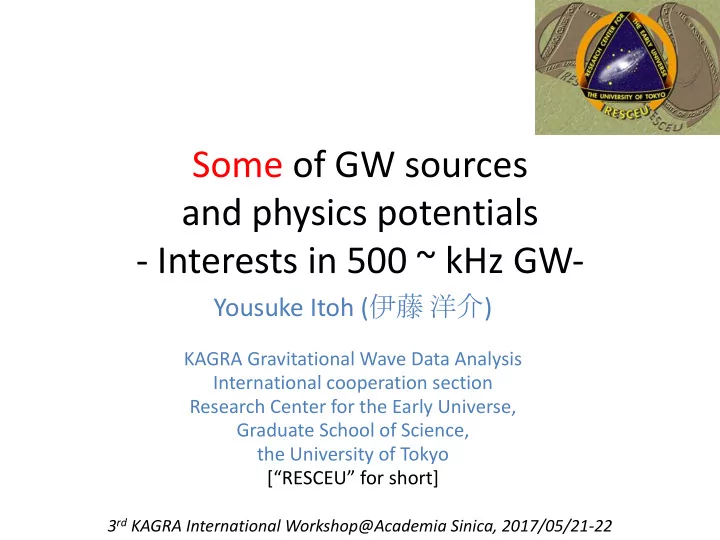

Some of GW sources and physics potentials - Interests in 500 ~ kHz GW- Yousuke Itoh ( 伊藤 洋介 ) KAGRA Gravitational Wave Data Analysis International cooperation section Research Center for the Early Universe, Graduate School of Science, the University of Tokyo [“RESCEU” for short] 3 rd KAGRA International Workshop@Academia Sinica, 2017/05/21-22
Interesting topics • Nuclear physics – EOS & hyperon puzzle: tidal disruption/deformability, mass-radius – site of r-process elements generation: SGRB/SNe? • Astrophysics – origins & evolution scenario(s) of SMBH [eLISA/PTA] – existence & formation of SMBH binaries (Last 1 parsec problem) [PTA] – existence & formation scenario(s) of IMBHs – verification binaries: “the calibration sources” or test of GR [eLISA] – Massive Black Hole Binary as a smoking gun of Pop III – r-process sites – short GRB: NS/NS or NS/BH? – Supernovae mechanism: neutrino, rotation – Supernovae: what will be left? BH or NS? – pulsar glitch – oscillations of compact stars à compactness, density, … – pulsar precession: Is it possible? (too low frequency … ?)
Interesting topics (cont’d) • test of GR – velocity of GW – polarizations of GW – Kerr-ness: QNM, quadrupole moment • Exotic objects – exotic compact objects: QNM, tidal deformability – Higher “mountain on” quark stars: (continuous wave) – echo by firewall??? – extra dimensions??? • Cosmology – Inflation (CMB B-mode, direct detection by Ultimate- DECIGO?) – Large scale structure with different method other than EM – gravitational lensing of gravitational wave – Primordial BH – cosmic strings – phase transition
O(100-1000) events/yr in the next decade. Report from the DAWN-II Workshop, Atlanta, GA, July 7-8, 2016 4
Interesting topics at 500-kHz (1) • Nuclear physics: EOS – site of r-process elements generation: SGRB/SNe? • Astrophysics – r-process sites – short GRB: NS/NS or NS/BH? – Supernovae mechanism(s): neutrino, rotation,SASI,.. – Supernovae: what will be left? BH or NS? – pulsar glitch – FRB, …
Detection prospects & r-elements abundance if NS binary origin Rosswog et al. (2017) CQG 34 104001 6
Localization LSC-V (2016) PRX 6, 041015 • galaxy density: 0.02 L 10 /Mpc 3 (Kopparapu et. al. ApJ. 2008) The number of galaxies in an observable volume (horizon distance 200Mpc) in 5 square degrees is O(10000). • sGRB 10 -7 events/Mpc 3 /yr or 3 if NS/NS, 160 events/yr if NS/BH for aLIGO (D. Yonetoku, et al. ApJ. 789 (2014) 65) 7
Follow-up: time resolution & FOV Assume 0.01Msun. CMOS 100 Mag. (red-opt/IR) CCD 22mag@200Mpc to 24mag (10 days after) FOV (sq. deg.) M. Tanaka (2016) Adv. Astron 17 19 10 22 Pan-STARR 20 Tomoe-Gozen iPTF 23 Decam HSC 15 25 SDSS 22 1 1 10 0.1 100 time resolution (s) circle size: limiting magnitude
EOS can be determined by how NS/NS are tidally disrupted? Takami, Rezzolla & Baiotti, PRL 113, 091104 (2014) NS/NS: merge at higher frequencies (kHz), HMNS f-mode ~ 2-4 kHz. 9
LV-UL distributions of ε & h 0 Known PSR search results on ”mountain heights” ℎ ∝ 𝜁𝑔 & LSC-V ApJ 839:12 (2017) Higher the frequency, more stringent the limit on epsilon is. [But msec PSR are old and probably more spherical?] 10
Interesting topics at 500-kHz (2) • test of GR • Deviation(s) in waveform from GR predictions • spin-quadrupole moment relation • Black-Hole spectroscopy • Exotic objects • QNM, tidal deformability, higher stellar mountain …
Tidal deformability and exotic objects Differences in tidal deformability among • normal objects (NS,BH) and exotic objects (Boson stars, Quark stars …) Kerr-ness [Spin-Quadrupole relation] • Quadrupole moment appears at 5 PN order in PN expansions For all those proposals, it is nicer to have a better sensitivity in higher frequency. 12
Test of GR N. Yunes, K. Yagi, & F. Pretorius LSC-VC PHYSICAL REVIEW X 6, 041015 PHYSICAL REVIEW D 94, 084002 (2016) (2016) Strong gravity -> Higher PN order -> Better to have a better sensitivity in higher frequency? 13
BH Spectroscopy Frequency of l=m=3 mode is higher than l=m=2 mode by ~ 1.5 times. If l=m=3 mode amplitude is 0(10%) of l=m=2 mode, need [Q 330 Sn(f 220 )/(Q 220 Sn(f 330 ))] 1/2 ~ 8. Too much à Better expect stacking or gold event Berti, Cardoso, & Will, PHYSICAL REVIEW D 73, 064030 (2006) 14
Summary today • First detection made by LIGO, more to come – Expect High ER: ~ 1 event/day in 202x (O5) • Higher frequency is (also) interesting, e.g., – Effects of extendedness of compact objects – Oscillations (QNMs) of remnants after mergers. – Stronger limit on non-sphericity of known PSRs 15
Recommend
More recommend